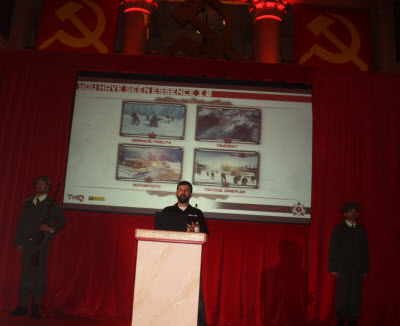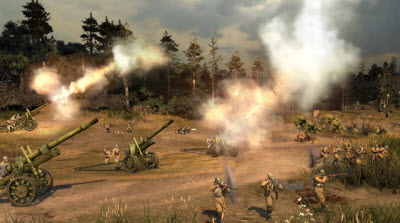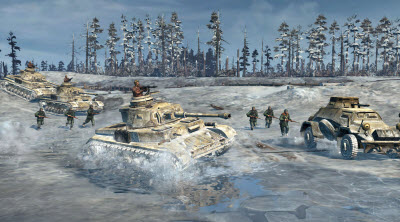GamesBeat: Is it hard to balance in multiplayer?
Duffy: Balance is always hard. There’s a few things. We’re a historical game, and we’re trying to deliver a sense of authenticity. We need to capture that tone. We need to fulfill the expectation of what a unit is like. We can’t have super-heavy tanks blowing up in an instant. That would break the expectation of what that vehicle should be able to do.
We also have a really broad constituency in this game. We have people who are really hardcore. We have people who are interested in historical war gaming. We have people who are interested in strategy games. We have casual players. Balance is different for each of those people. It means different things. We try to accommodate that breadth of people, and that’s sometimes a challenge.
 GamesBeat: It seems like there’s always some central point to fight over in the map, and then ways to go around it. Does that sound like the usual design of a map?
GamesBeat: It seems like there’s always some central point to fight over in the map, and then ways to go around it. Does that sound like the usual design of a map?
Duffy: We have two map modes that we’re looking at. There’s the frontline mode, and there’s what we call a battlefield. The frontline maps are more symmetrical. We have three victory points that you fight over on every map. You want to own a majority of those and start ticking down your opponent’s points.
The battlefield maps are more asymmetrical. It puts pressure on the players to determine whether they want to capture resources or capture victory points. It’s more cutoff gameplay. The territories, much like supply lines, can be cut off, and that prevents players from earning those resources.
It differs by map, too. Winter maps are different from summer maps as far as the routes you take. Deep snow has an impact on your guys moving around, and obviously, you don’t want to be crossing ice all the time. That can be deadly.
GamesBeat: You guys have an extra couple of months to finish up. Was there a particular reason to take the extra time?
Duffy: It’s indicative of the support we’re getting. The game is good, and we want it to be really good. [Laughs] That’s it in a nutshell, sort of. That’s what we’re aiming at. It gives us more time for polish.
GamesBeat: THQ isn’t in the greatest shape these days. Does that sort of hang over your head as you finish the game?
Duffy: No. We’re focused on the game. For us, the day-to-day activities haven’t changed. We’re building the game. We’re building the upcoming beta tests. We’re building for these events. Our focus is on the game. I don’t think much beyond that at this point.
GamesBeat: In general, then, is it proceeding the way you want it to as far as development goes?
Duffy: Well, you always want more. Every developer would love more. In my role, I’m trying to spend all the money everywhere as quickly as I can. But you have to balance what’s good for the game. Sometimes there are decisions to be made.
 GamesBeat: How long has it been in the works at this point?
GamesBeat: How long has it been in the works at this point?
Duffy: Let’s see. We went to Russia in February of 2011, so we’d started just a bit before that. We had started on a Soviet expansion pack for the original Company of Heroes quite a long time ago, though, so that laid the groundwork for some of the things we were interested in doing.
GamesBeat: Are you saving some things for afterward, for post-launch?
Duffy: We have a pretty robust plan for post-launch [downloadable content]. We talked about skins and commanders and the kinds of things that we’d like to be able to deliver to the player. It’s not really a question of “saving” things because that’s always a terrible impression to give, that you’ve held stuff back. We just want to give players a reason to play long-term and be invested in the game. We want to deliver stuff for them.
GamesBeat: I was curious about one thing in the game. Can you actually sort of gang up on a tank and take it down?
Duffy: If you have the right weapons. Rifle fire or machine gun fire will never kill a tank. You need antitank weapons. You need antitank rifles or grenades or whatever it is. You can eventually whittle down even the biggest tank with those.
GamesBeat: Would your grenadiers, say the German grenadiers, have that?
Duffy: They need Panzerfausts or Panzerschrecks, upgrades like that.
GamesBeat: So upgrading is something you can overlook, but it’s important.
Duffy: One of the things we have in the game is that manpower is the core resource. You’ll always have a unit that costs only manpower. An antitank gun only costs manpower. An upgrade costs you munitions to use, but an antitank gun is free in that sense. It’s just a unit you have to buy. It gives players some options and some flexibility. If they want to have a munition-heavy army with lots of grenades and rockets and bombs, they need to build and capture munition plants.
 GamesBeat: Your aircraft Stuka missions, is there a way to control that at all? You pick a target area, and then it just flies over.
GamesBeat: Your aircraft Stuka missions, is there a way to control that at all? You pick a target area, and then it just flies over.
Duffy: We changed up the planes a little bit. The plane actually loiters for a time and picks targets to attack automatically within a given area. It gives you a sort of umbrella of protection, much like an A-10 circling over infantry forces today gives them that umbrella. It’ll attack high-priority targets that enter into its loiter. But the other thing is that it’s counterable. An antiaircraft vehicle or the heavy machine gun on top of a tank can fire at that Stuka. When we talked about some of these new commander abilities. I mentioned the balancing. Some of them were just a sort of “kill” button. We wanted to make sure that these systems had counters to them. There are counters to airstrikes, with machine-gun fire and stuff like that.
GamesBeat: How did you decide what was appropriate as far as the size of the maps?
Duffy: It’s pretty simple. When you get a map where there’s no fighting in the first five minutes, it’s probably too big. Based on the weapon ranges on the units and their sight ranges. … We find that the maps can go up to about half a kilometer on a side. Those feel pretty big. Lots of space out there.
GamesBeat: If you wanted to set up some particular options, how customizable is it? Say you wanted to have nothing but tanks fighting in a multiplayer game. Could you do that?
Duffy: You could, yeah. There are some things that we’re looking at, like limiting the tech tree by date. There are different ways to do that. I don’t know if we’re going to ship with a mode like that in particular, but we find that if we give the mod community a bit of time afterwards, they’ll introduce all kinds of cool stuff.
VentureBeat's mission is to be a digital town square for technical decision-makers to gain knowledge about transformative enterprise technology and transact. Learn More
